Assimilation of Deep Learning and Machine Learning Schemes into a Remote Sensing-Incorporated Crop Model to Simulate Barley and Wheat Productivities
Abstract
1. Introduction
2. Materials and Methods
2.1. Field Experiment
2.2. Proximal and UAS-Based Remote Sensing Data
2.3. Model Design
2.4. DNN and ML Regression Models
2.5. Model Evaluation
3. Results
3.1. DNN and ML Evaluation
3.2. RSCM Evaluation
3.3. Geographical Projection
4. Discussion
5. Conclusions
Author Contributions
Funding
Data Availability Statement
Acknowledgments
Conflicts of Interest
Appendix A




| Crop | Treatment | LAI (mean ± 1 SD) | MAE | RMSD | ME | |
|---|---|---|---|---|---|---|
| Simulated | Observed | |||||
| --------- m−2 --------- | ---- m−2 ---- | unitless | ||||
| Wheat | AN1 | 2.58 ± 1.34 | 2.64 ± 1.40 | 0.29 | 0.39 | 0.919 |
| AN2 | 2.82 ± 1.41 | 2.91 ± 1.52 | 0.31 | 0.41 | 0.925 | |
| AN3 | 3.01 ± 1.57 | 3.22 ± 1.75 | 0.35 | 0.52 | 0.906 | |
| SN | 2.55 ± 0.82 | 2.61 ± 0.92 | 0.44 | 0.54 | 0.631 | |
| Barley | AN | 1.71 ± 0.81 | 1.70 ± 0.85 | 0.16 | 0.21 | 0.938 |
| SN | 1.46 ± 0.80 | 1.61 ± 0.78 | 0.32 | 0.37 | 0.766 | |
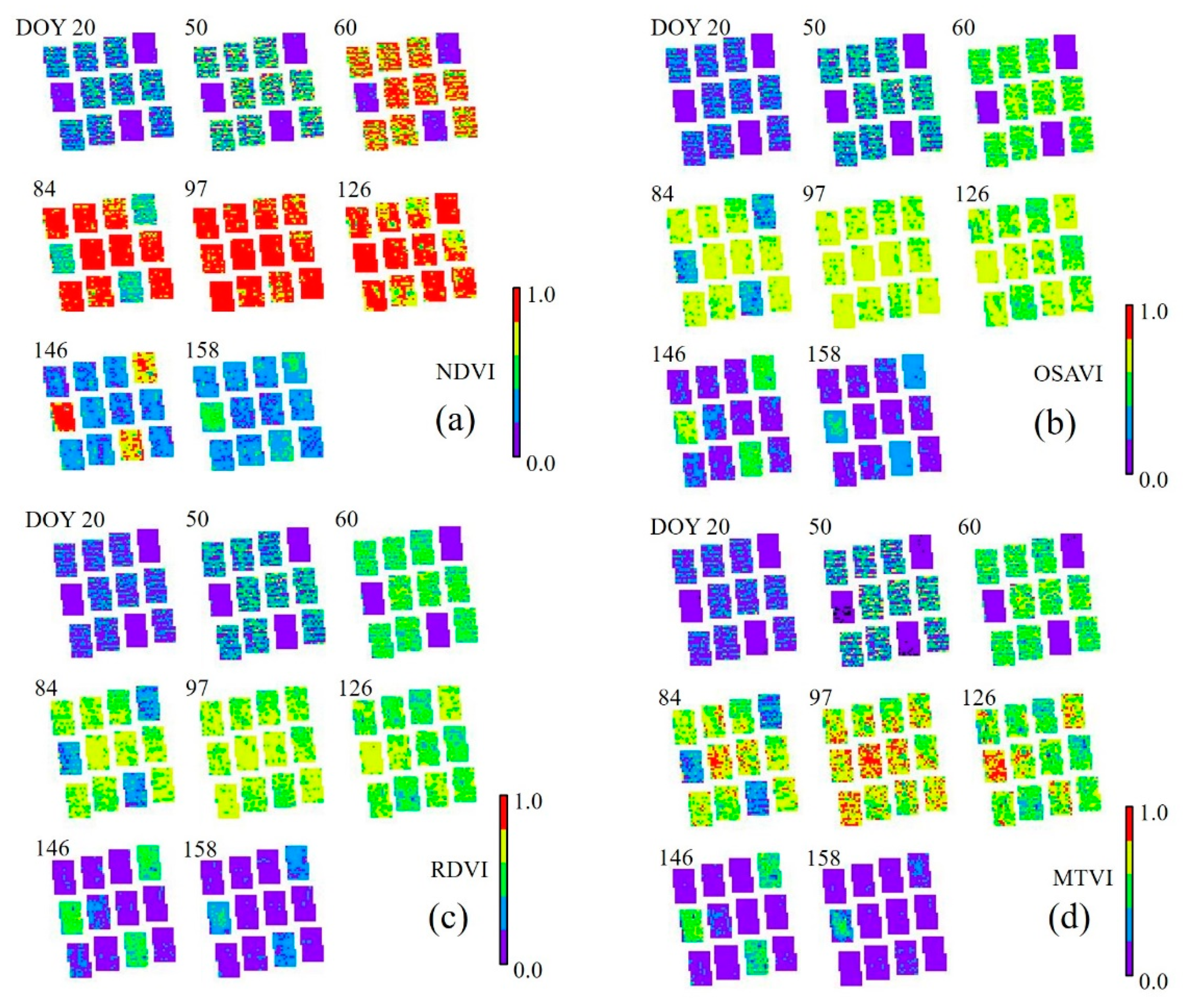
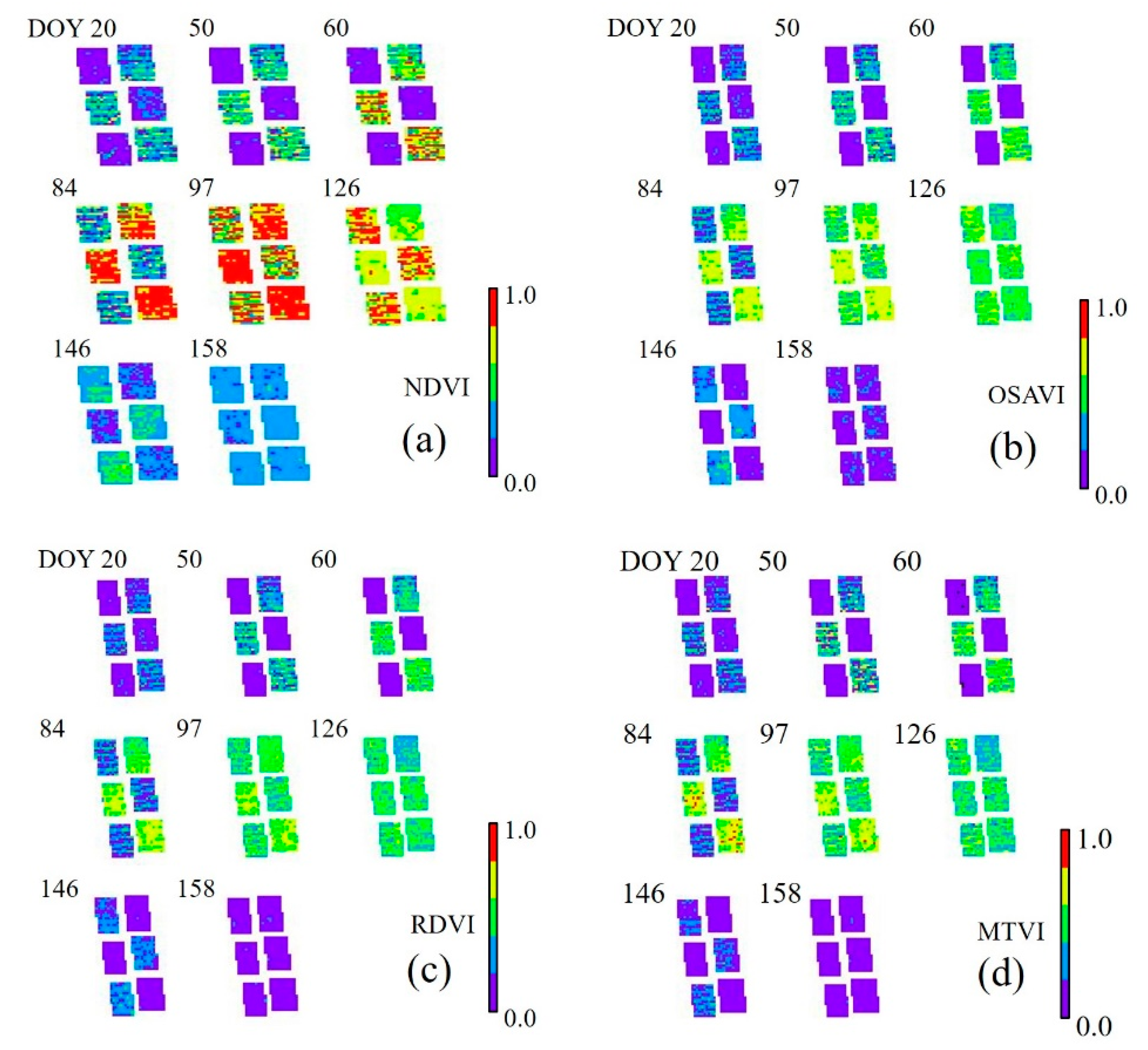
References
- Khaki, S.; Wang, L.; Archontoulis, S.V. A CNN-RNN framework for crop yield prediction. Front. Plant Sci. 2020, 10, 1750. [Google Scholar] [CrossRef] [PubMed]
- Kim, N.; Na, S.-I.; Park, C.-W.; Huh, M.; Oh, J.; Ha, K.-J.; Cho, J.; Lee, Y.-W. An artificial intelligence approach to prediction of corn yields under extreme weather conditions using satellite and meteorological data. Appl. Sci. 2020, 10, 3785. [Google Scholar] [CrossRef]
- Kumar, P.; Prasad, R.; Choudhary, A.; Gupta, D.K.; Mishra, V.N.; Vishwakarma, A.K.; Singh, A.K.; Srivastava, P.K. Comprehensive evaluation of soil moisture retrieval models under different crop cover types using C-band synthetic aperture radar data. Geocarto Int. 2019, 34, 1022–1041. [Google Scholar] [CrossRef]
- Everingham, Y.; Sexton, J.; Skocaj, D.; Inman-Bamber, G. Accurate prediction of sugarcane yield using a random forest algorithm. Agron. Sustain. Dev. 2016, 36, 27. [Google Scholar] [CrossRef]
- Feng, P.; Wang, B.; Li Liu, D.; Waters, C.; Yu, Q. Incorporating machine learning with biophysical model can improve the evaluation of climate extremes impacts on wheat yield in south-eastern Australia. Agric. For. Meteorol. 2019, 275, 100–113. [Google Scholar] [CrossRef]
- Shahhosseini, M.; Hu, G.; Huber, I.; Archontoulis, S.V. Coupling machine learning and crop modelling improves crop yield prediction in the US Corn Belt. Sci. Rep. 2021, 11, 1606. [Google Scholar] [CrossRef] [PubMed]
- Cai, Y.; Guan, K.; Nafziger, E.; Chowdhary, G.; Peng, B.; Jin, Z.; Wang, S.; Wang, S. Detecting in-season crop nitrogen stress of corn for field trials using UAV- and CubeSat-based multispectral sensing. IEEE J. Sel. Top. Appl. Earth Obs. Remote Sens. 2019, 12, 5153–5166. [Google Scholar] [CrossRef]
- van Klompenburg, T.; Kassahun, A.; Catal, C. Crop yield prediction using machine learning: A systematic literature review. Comput. Electron. Agric. 2020, 177, 105709. [Google Scholar] [CrossRef]
- Jeong, S.; Ko, J.; Yeom, J.-M. Predicting rice yield at pixel scale through synthetic use of crop and deep-learning models with satellite data in South and North Korea. Sci. Total Environ. 2022, 802, 149726. [Google Scholar] [CrossRef] [PubMed]
- Jeong, S.; Ko, J.; Shin, T.; Yeom, J.-m. Incorporation of machine learning and deep neural network approaches into a remote sensing-integrated crop model for the simulation of rice growth. Sci. Rep. 2022, 12, 9030. [Google Scholar] [CrossRef] [PubMed]
- Campbell, J.B.; Wynne, R.H. Introduction to Remote Sensing; Guilford Press: New York, NY, USA, 2011. [Google Scholar]
- Khanal, S.; KC, K.; Fulton, J.P.; Shearer, S.; Ozkan, E. Remote sensing in agriculture—Accomplishments, limitations, and opportunities. Remote Sens. 2020, 12, 3783. [Google Scholar] [CrossRef]
- Dorigo, W.A.; Zurita-Milla, R.; de Wit, A.J.W.; Brazile, J.; Singh, R.; Schaepman, M.E. A review on reflective remote sensing and data assimilation techniques for enhanced agroecosystem modelling. Int. J. Appl. Earth Obs. Geoinf. 2007, 9, 165–193. [Google Scholar] [CrossRef]
- Zarco-Tejada, P.J.; Ustin, S.L.; Whiting, M.L. Temporal and spatial relationships between within-field yield variability in cotton and high-spatial hyperspectral remote sensing imagery. Agron. J. 2005, 97, 641–653. [Google Scholar] [CrossRef]
- Kern, A.; Barcza, Z.; Marjanović, H.; Árendás, T.; Fodor, N.; Bónis, P.; Bognár, P.; Lichtenberger, J. Statistical modelling of crop yield in Central Europe using climate data and remote sensing vegetation indices. Agric. For. Meteorol. 2018, 260, 300–320. [Google Scholar] [CrossRef]
- Labus, M.P.; Nielsen, G.A.; Lawrence, R.L.; Engel, R.; Long, D.S. Wheat yield estimates using multi-temporal NDVI satellite imagery. Int. J. Remote Sens. 2002, 23, 4169–4180. [Google Scholar] [CrossRef]
- Delécolle, R.; Maas, S.J.; Guérif, M.; Baret, F. Remote sensing and crop production models: Present trends. ISPRS J. Photogramm. Remote Sens. 1992, 47, 145–161. [Google Scholar] [CrossRef]
- Becker-Reshef, I.; Vermote, E.; Lindeman, M.; Justice, C. A generalised regression-based model for forecasting winter wheat yields in Kansas and Ukraine using MODIS data. Remote Sens. Environ. 2010, 114, 1312–1323. [Google Scholar] [CrossRef]
- Jones, J.W.; Hoogenboom, G.; Porter, C.H.; Boote, K.J.; Batchelor, W.D.; Hunt, L.; Wilkens, P.W.; Singh, U.; Gijsman, A.J.; Ritchie, J.T. The DSSAT cropping system model. Eur. J. Agron. 2003, 18, 235–265. [Google Scholar] [CrossRef]
- van Diepen, C.A.; Wolf, J.; van Keulen, H.; Rappoldt, C. WOFOST: A simulation model of crop production. Soil Use Manag. 1989, 5, 16–24. [Google Scholar] [CrossRef]
- Cao, J.; Zhang, Z.; Tao, F.; Zhang, L.; Luo, Y.; Zhang, J.; Han, J.; Xie, J. Integrating multi-source data for rice yield prediction across China using machine learning and deep learning approaches. Agric. For. Meteorol. 2021, 297, 108275. [Google Scholar] [CrossRef]
- Maas, S.J. Parameterized model of gramineous crop growth: II. within-season simulation calibration. Agron. J. 1993, 85, 354–358. [Google Scholar] [CrossRef]
- Nguyen, V.; Jeong, S.; Ko, J.; Ng, C.; Yeom, J. Mathematical integration of remotely sensed information into a crop modelling process for mapping crop productivity. Remote Sens. 2019, 11, 2131. [Google Scholar] [CrossRef]
- Huang, J.; Gómez-Dans, J.L.; Huang, H.; Ma, H.; Wu, Q.; Lewis, P.E.; Liang, S.; Chen, Z.; Xue, J.-H.; Wu, Y.; et al. Assimilation of remote sensing into crop growth models: Current status and perspectives. Agric. For. Meteorol. 2019, 276, 107609. [Google Scholar] [CrossRef]
- Jin, X.; Kumar, L.; Li, Z.; Feng, H.; Xu, X.; Yang, G.; Wang, J. A review of data assimilation of remote sensing and crop models. Eur. J. Agron. 2018, 92, 141–152. [Google Scholar] [CrossRef]
- Shawon, A.R.; Ko, J.; Ha, B.; Jeong, S.; Kim, D.K.; Kim, H.-Y. Assessment of a proximal sensing-integrated crop model for simulation of soybean growth and yield. Remote Sens. 2020, 12, 410. [Google Scholar] [CrossRef]
- Shawon, A.R.; Ko, J.; Jeong, S.; Shin, T.; Lee, K.D.; Shim, S.I. Two-dimensional simulation of barley growth and yield using a model integrated with remote-controlled aerial imagery. Remote Sens. 2020, 12, 3766. [Google Scholar] [CrossRef]
- Shin, T.; Ko, J.; Jeong, S.; Shawon, A.R.; Lee, K.D.; Shim, S.I. Simulation of wheat productivity using a model integrated with proximal and remotely controlled aerial sensing information. Front. Plant Sci. 2021, 12, 649660. [Google Scholar] [CrossRef]
- Jeong, S.; Ko, J.; Choi, J.; Xue, W.; Yeom, J.-M. Application of an unmanned aerial system for monitoring paddy productivity using the GRAMI-rice model. Int. J. Remote Sens. 2018, 39, 2441–2462. [Google Scholar] [CrossRef]
- Jeong, S.; Ko, J.; Kang, M.; Yeom, J.; Ng, C.T.; Lee, S.-H.; Lee, Y.-G.; Kim, H.-Y. Geographical variations in gross primary production and evapotranspiration of paddy rice in the Korean Peninsula. Sci. Total Environ. 2020, 714, 136632. [Google Scholar] [CrossRef]
- Yeom, J.-M.; Jeong, S.; Deo, R.C.; Ko, J. Mapping rice area and yield in north-eastern Asia by incorporating a crop model with dense vegetation index profiles from a geostationary satellite. GIScience Remote Sens. 2021, 58, 1–27. [Google Scholar] [CrossRef]
- Rouse, J.W., Jr.; Haas, R.H.; Schell, J.A.; Deering, D.W. Monitoring vegetation systems in the Great Plains with ERTS. In Proceedings of the NASA Goddard Space Flight Center 3d ERTS-1 Symp., Washington, DC, USA, 1 January 1974; pp. 309–317. [Google Scholar]
- Rondeaux, G.; Steven, M.; Baret, F. Optimization of soil-adjusted vegetation indices. Remote Sens. Environ. 1996, 55, 95–107. [Google Scholar] [CrossRef]
- Haboudane, D.; Miller, J.R.; Pattey, E.; Zarco-Tejada, P.J.; Strachan, I.B. Hyperspectral vegetation indices and novel algorithms for predicting green LAI of crop canopies: Modeling and validation in the context of precision agriculture. Remote Sens. Environ. 2004, 90, 337–352. [Google Scholar] [CrossRef]
- Roujean, J.-L.; Breon, F.-M. Estimating PAR absorbed by vegetation from bidirectional reflectance measurements. Remote Sens. Environ. 1995, 51, 375–384. [Google Scholar] [CrossRef]
- Monteith, J.L. Solar radiation and productivity in tropical ecosystems. J. Appl. Ecol. 1972, 9, 747–766. [Google Scholar] [CrossRef]
- Press, W.H.; Teukolsky, S.A.; Vetterling, W.T.; Flannery, B.P. Numerical Recipes: The Art of Scientific Computing; Cambridge University Press: New York, NY, USA, 1992. [Google Scholar]
- Nash, J.C. Compact Numerical Methods for Computers: Linear Algebra and Function Minimisation; CRC Press: New York, NY, USA, 1990. [Google Scholar]
- Yeom, J.-M.; Jeong, S.; Jeong, G.; Ng, C.T.; Deo, R.C.; Ko, J. Monitoring paddy productivity in North Korea employing geostationary satellite images integrated with GRAMI-rice model. Sci. Rep. 2018, 8, 16121. [Google Scholar] [CrossRef]
- Ko, J.; Jeong, S.; Yeom, J.; Kim, H.; Ban, J.-O.; Kim, H.-Y. Simulation and mapping of rice growth and yield based on remote sensing. J. Appl. Remote Sens. 2015, 9, 096067. [Google Scholar] [CrossRef]
- Nash, J.E.; Sutcliffe, J.V. River flow forecasting through conceptual models part I—A discussion of principles. J. Hydrol. 1970, 10, 282–290. [Google Scholar] [CrossRef]
- Bui, D.T.; Tsangaratos, P.; Nguyen, V.-T.; Liem, N.V.; Trinh, P.T. Comparing the prediction performance of a Deep Learning Neural Network model with conventional machine learning models in landslide susceptibility assessment. CATENA 2020, 188, 104426. [Google Scholar] [CrossRef]
- Sahoo, A.K.; Pradhan, C.; Das, H. Performance evaluation of different machine learning methods and deep-learning based convolutional neural network for health decision making. In Nature Inspired Computing for Data Science; Rout, M., Rout, J.K., Das, H., Eds.; Springer: Berlin/Heidelberg, Germany, 2020; pp. 201–212. [Google Scholar]
- Lövenstein, H.; Rabbinge, R.; van Keulen, H. World Food Production, Textbook 2: Biophysical Factors in Agricultural Production; Wageningen University & Research: Wageningen, The Netherlands, 1992. [Google Scholar]
- Ahuja, L.R.; Rojas, K.W.; Hanson, J.D.; Shaffer, M.J.; Ma, L. Root Zone Water Quality Model: Modelling Management Effects on Water Quality and Crop Production; Water Resources Publications, LLC.: Highland Ranch, CO, USA, 2000. [Google Scholar]
- Jeong, S.; Shin, T.; Ban, J.-O.; Ko, J. Simulation of spatiotemporal variations in cotton lint yield in the Texas High Plains. Remote Sens. 2022, 14, 1421. [Google Scholar] [CrossRef]
- Johnson, D.M. An assessment of pre-and within-season remotely sensed variables for forecasting corn and soybean yields in the United States. Remote Sens. Environ. 2014, 141, 116–128. [Google Scholar] [CrossRef]
- Bolton, D.K.; Friedl, M.A. Forecasting crop yield using remotely sensed vegetation indices and crop phenology metrics. Agric. For. Meteorol. 2013, 173, 74–84. [Google Scholar] [CrossRef]
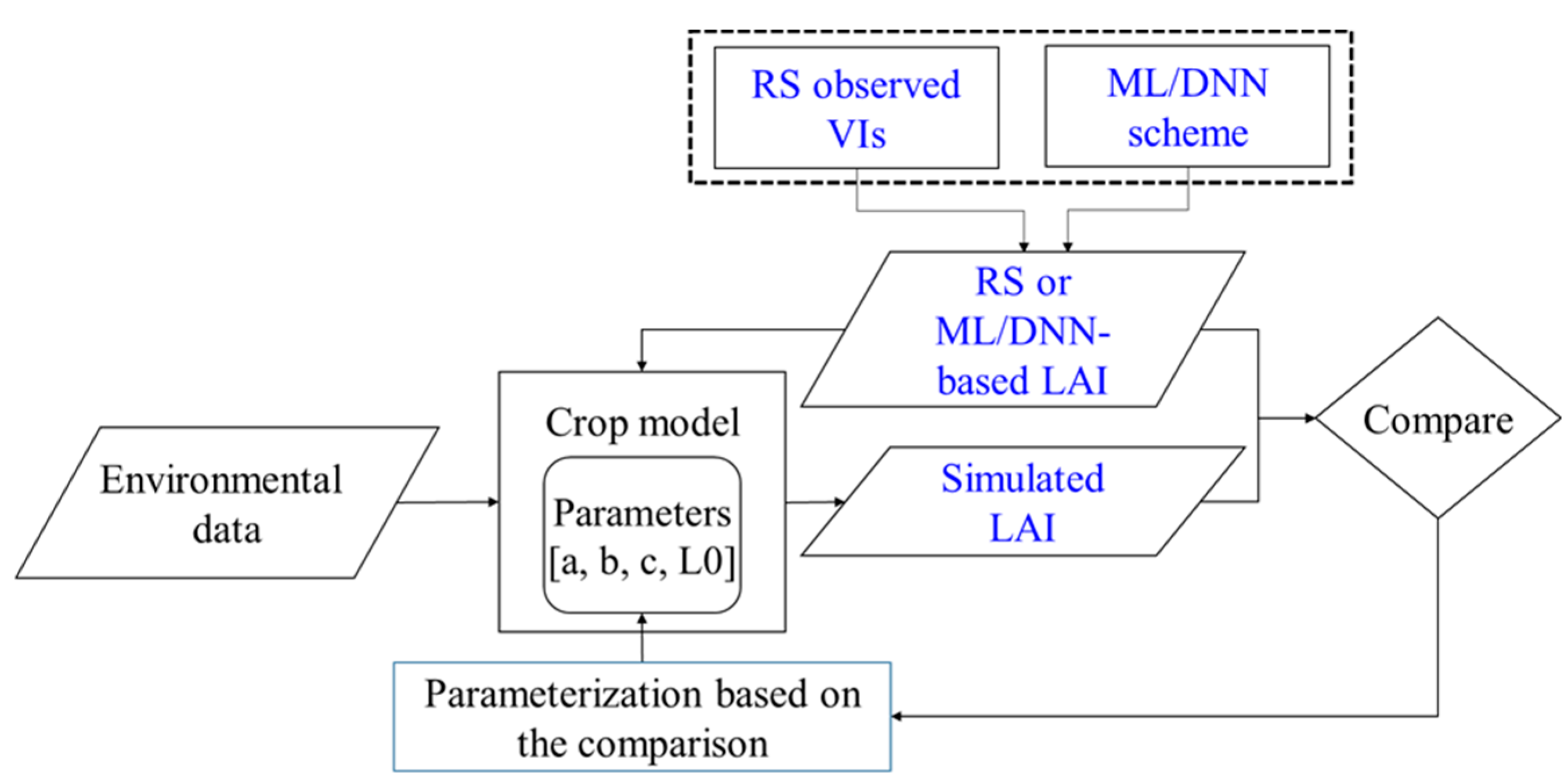
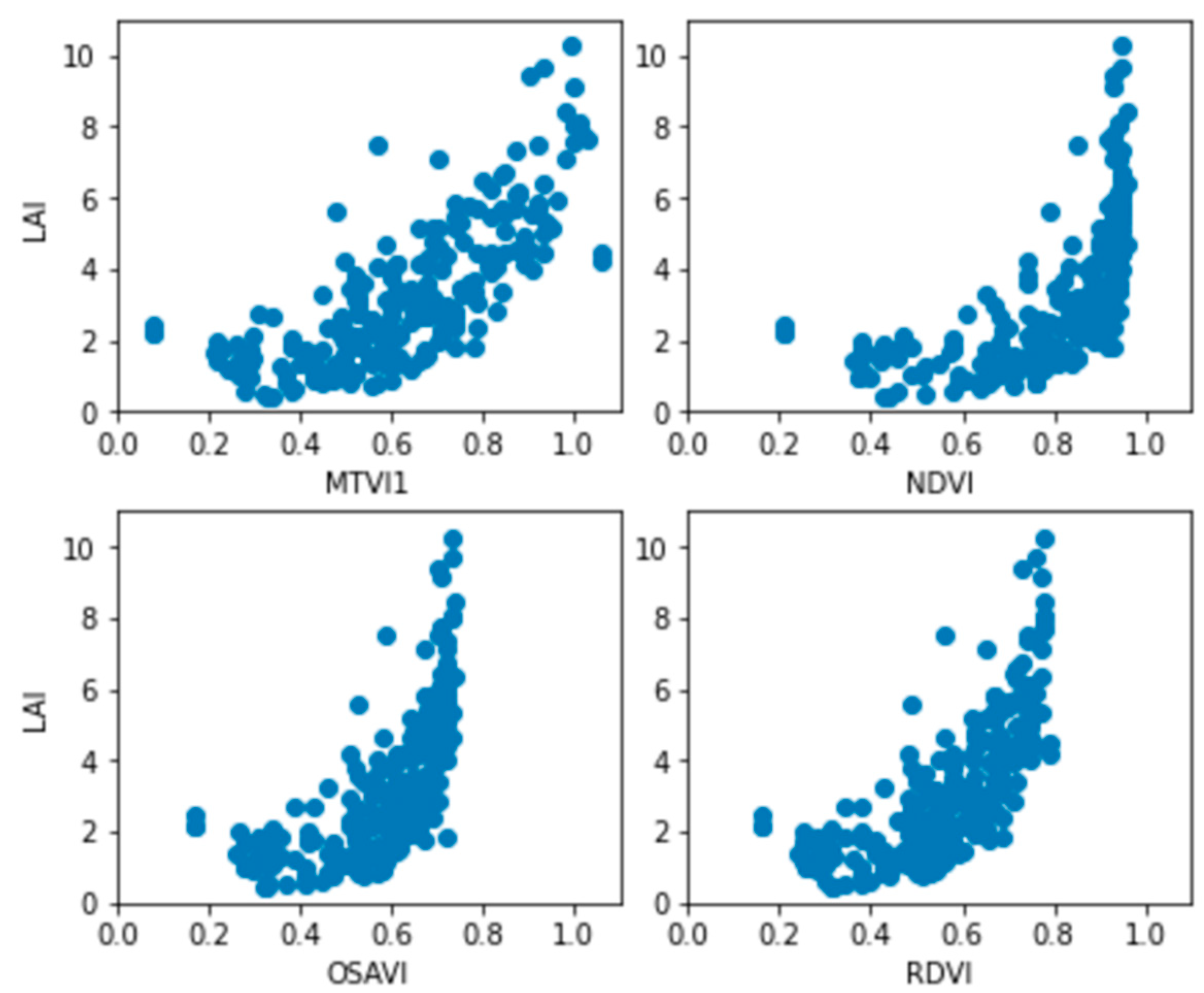
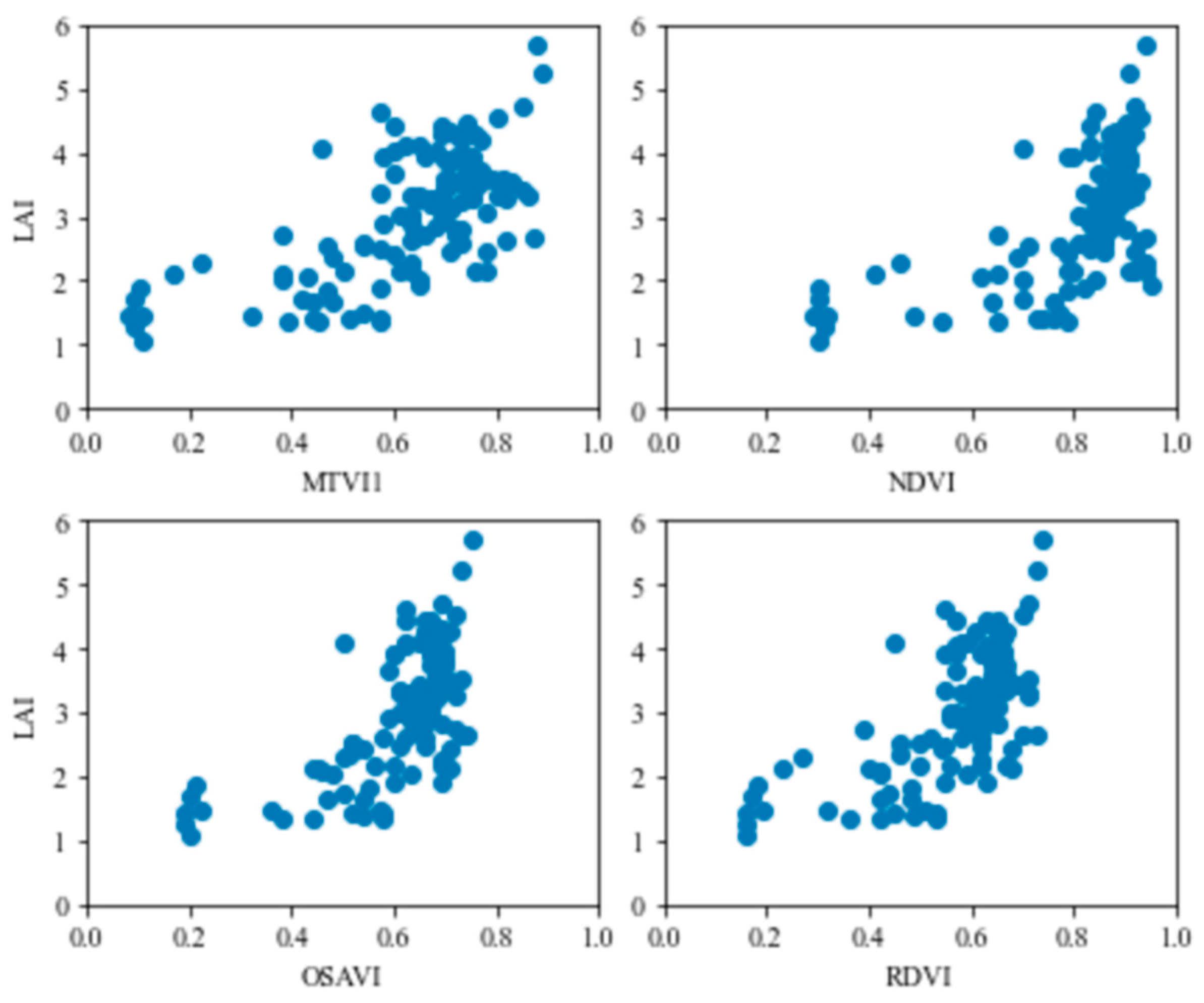

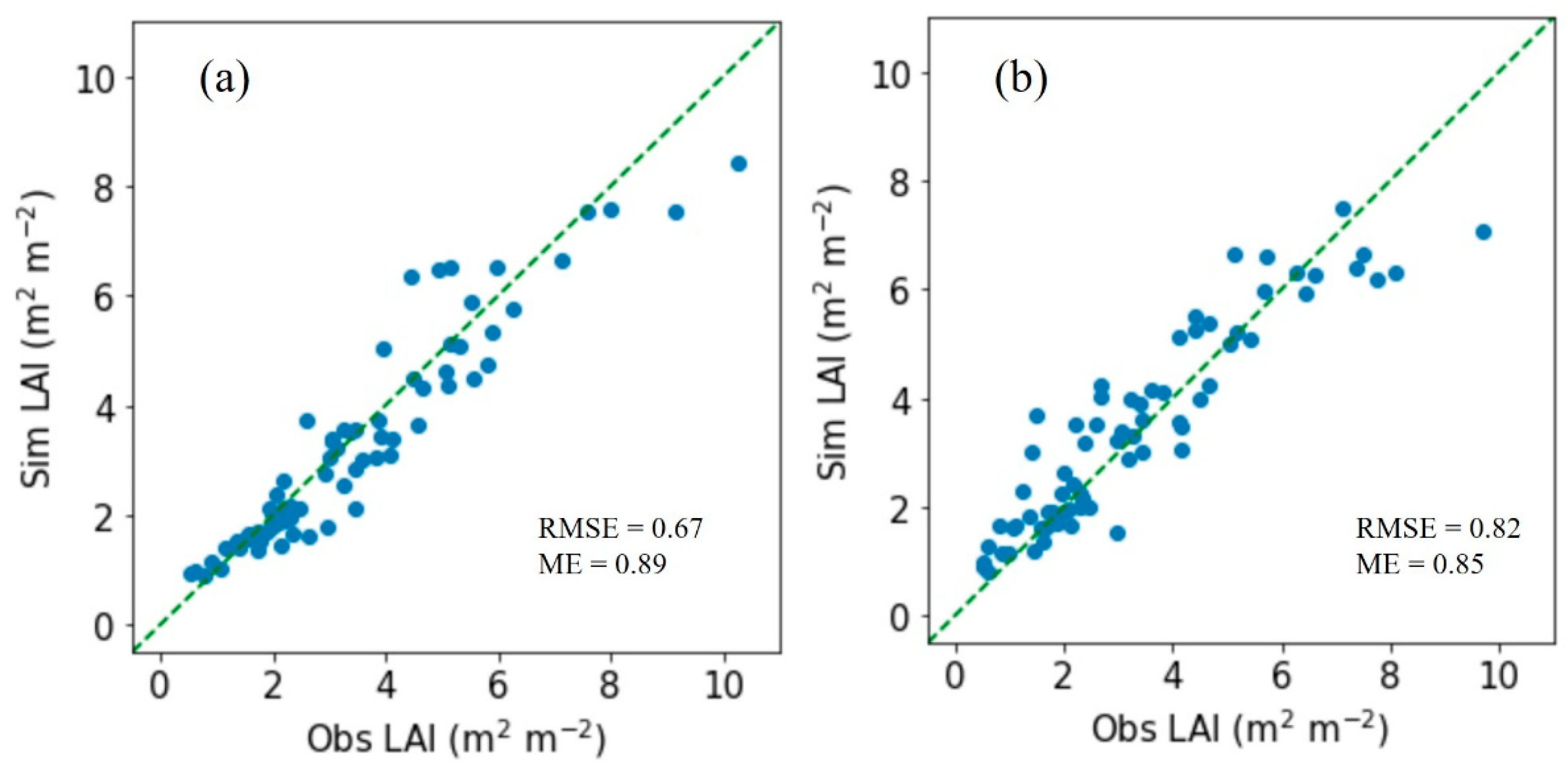
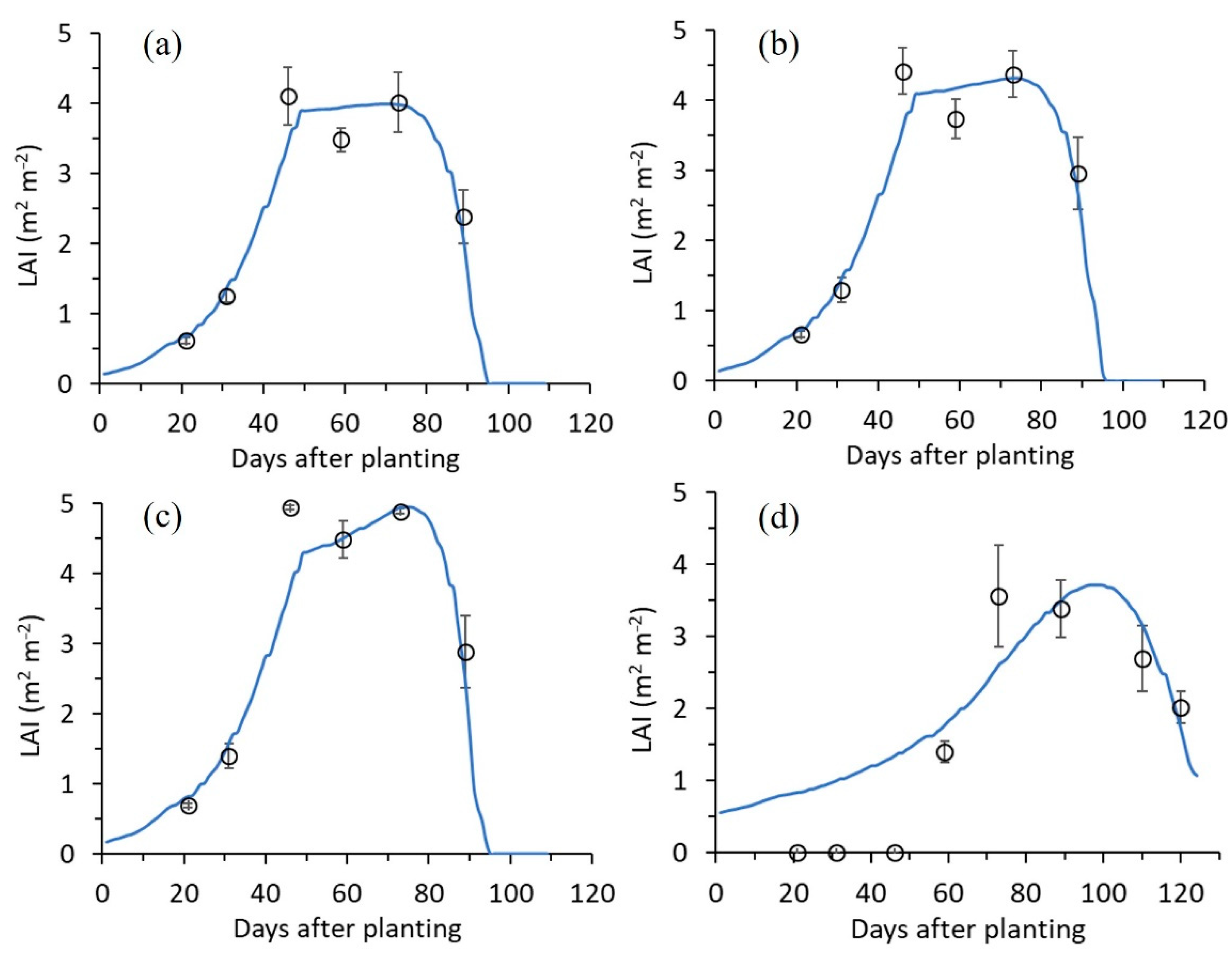
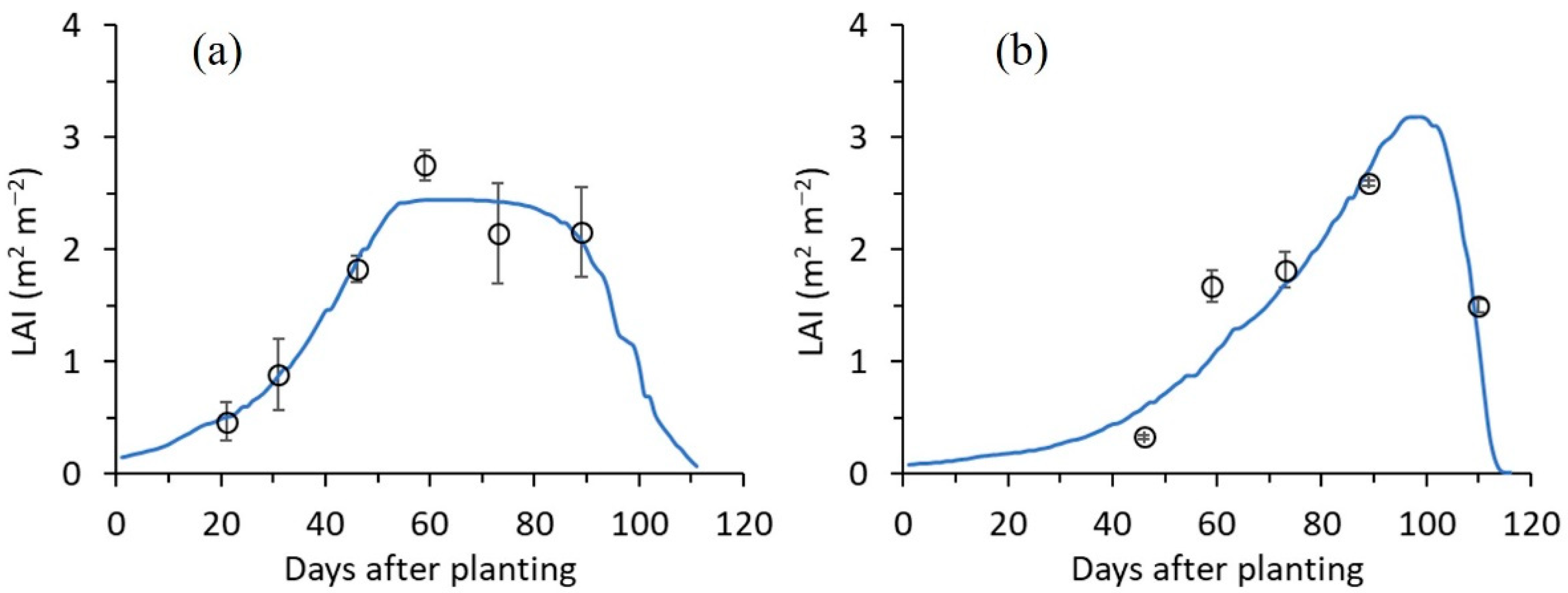
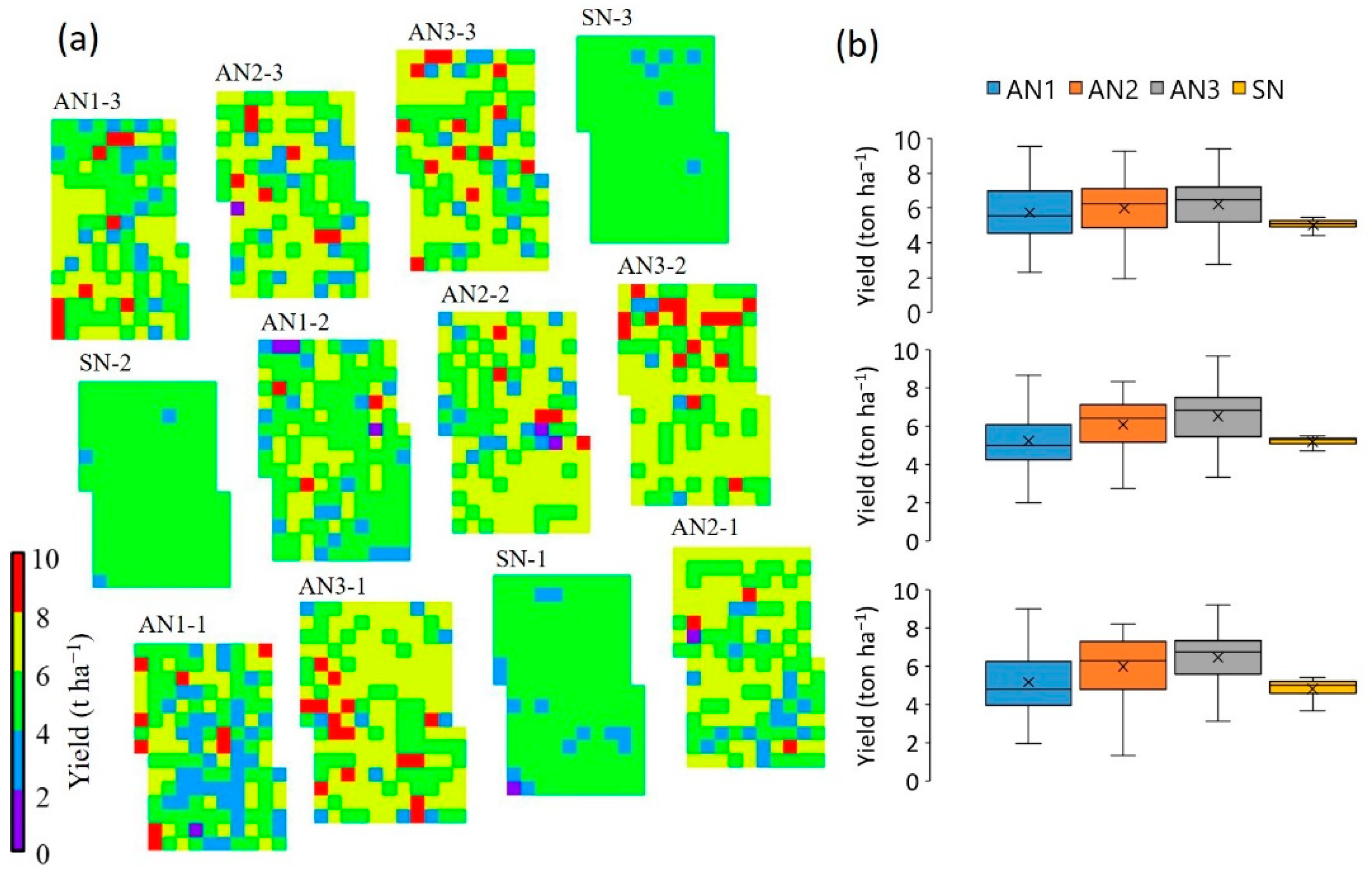
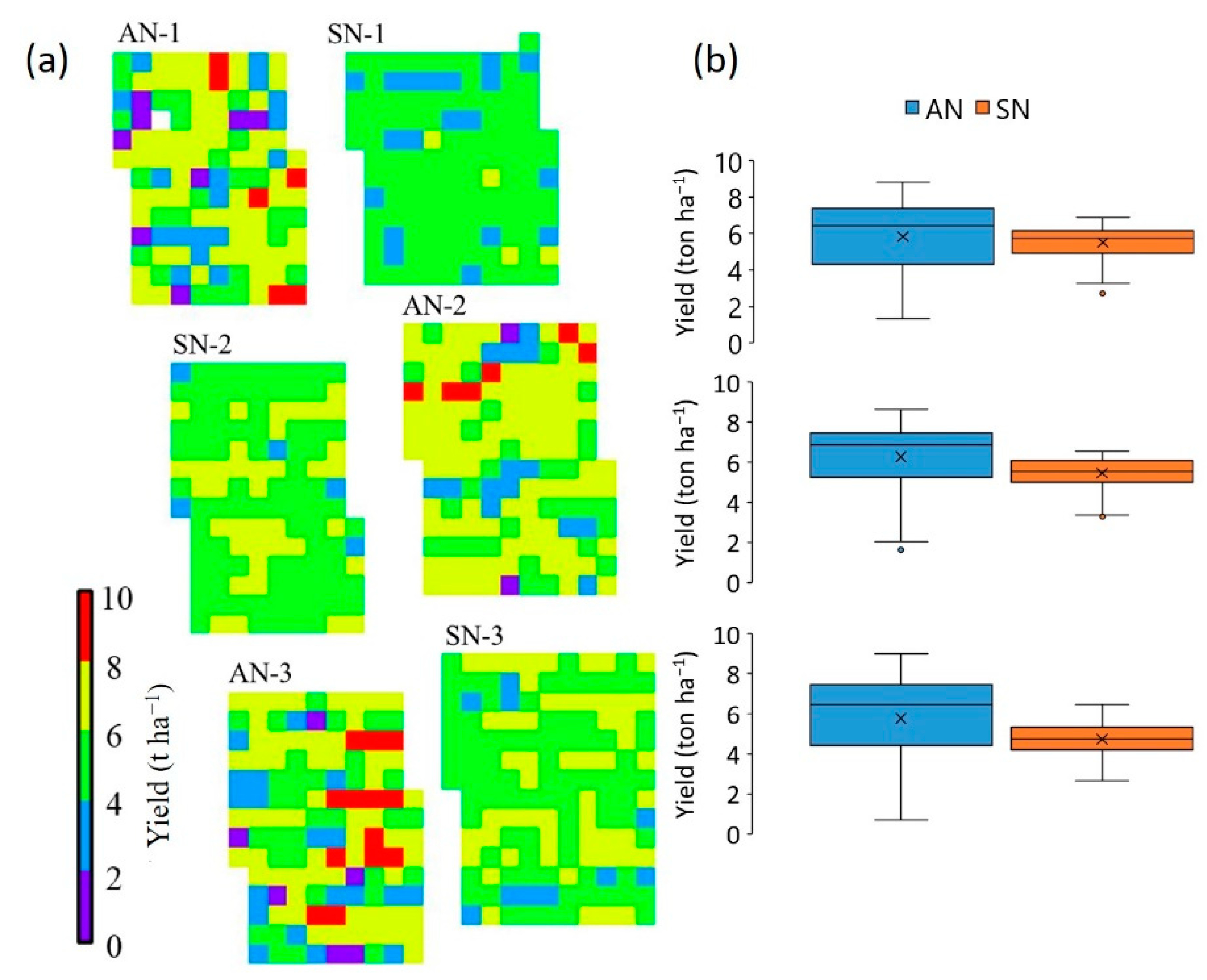
| Division | Unit † | 2018 | 2019 | 2020 | 2021 |
|---|---|---|---|---|---|
| Seeding | DD/MM/YY | 30/10/17 | 05/11/18 (18/02/19) | 30/10/19 (20/02/20) | 30/10/20 (19/02/21) |
| Harvest | DD/MM/YY | 25/06/18 | 10/06/19 | 09/06/20 | 07/06/21 |
| LAI measurement | DOY | 87, 101, 115, 130, 144 | 68, 81, 102, 111, 145 | 62, 79, 93, 107, 129, 143 | 59, 69, 84, 97, 111, 127 |
| UAS image acquisition | DOY | 87, 101, 115, 130, 144, 158 | 53, 67, 81, 102, 123, 144 | 75, 85, 99, 107, 120, 134, 143 | 20, 50, 60, 84, 97, 126, 146, 158 |
| Temperature | °C | 8.79 | 8.28 | 15.96 | 15.55 |
| Solar radiation | MJ m−2 d−1 | 11.81 | 13.11 | 15.81 | 14.71 |
| Precipitation | mm d−1 | 2.96 | 1.95 | 2.60 | 2.05 |
| Regressor | Barely | Wheat | ||
|---|---|---|---|---|
| Training | Test | Training | Test | |
| Extra Trees | 0.999 | 0.778 | 0.999 | 0.681 |
| Gradient Boosting | 0.972 | 0.814 | 0.991 | 0.685 |
| HGB | 0.918 | 0.790 | 0.568 | 0.335 |
| Lasso | 0.843 | 0.787 | 0.612 | 0.492 |
| LGBM | 0.915 | 0.773 | 0.542 | 0.344 |
| Polynomial Linear | 0.872 | 0.759 | 0.714 | 0.455 |
| Random Forest | 0.975 | 0.803 | 0.947 | 0.631 |
| Ridge | 0.872 | 0.761 | 0.609 | 0.502 |
| Support Vector | 0.863 | 0.771 | 0.733 | 0.525 |
| XGB | 0.999 | 0.782 | 0.999 | 0.554 |
| Crop | GB | DNN | ||||||||
|---|---|---|---|---|---|---|---|---|---|---|
| Sim | Obs | MAE | RMSD | ME | Sim | Obs | MAE | RMSD | ME | |
| --------------- m2 m−2 ------------- | None | -------------- m2 m−2 -------------- | None | |||||||
| Barley | 3.32 ± 1.92 | 3.47 ± 2.02 | 0.49 | 0.67 | 0.89 | 3.45 ± 1.84 | 3.32 ± 2.10 | 0.62 | 0.82 | 0.85 |
| Wheat | 2.93 ± 0.75 | 2.81 ± 0.97 | 0.59 | 0.71 | 0.45 | 2.93 ± 0.64 | 3.07 ± 0.84 | 0.54 | 0.64 | 0.41 |
| Treatment | Yield (mean ± 1 SD) | p | MAE | RMSD | NME | |
|---|---|---|---|---|---|---|
| Simulated | Observed | |||||
| --------- tonne ha−1 --------- | unitless | ---- tonne ha−1 ---- | unitless | |||
| AN1 | 4.538 ± 0.237 | 4.415 ± 1.049 | 0.850 | 0.659 | 0.754 | 1.000 |
| AN2 | 5.611 ± 0.206 | 5.920 ± 0.766 | 0.537 | 0.546 | 0.594 | 0.995 |
| AN3 | 7.221 ± 0.232 | 7.627 ± 1.512 | 0.669 | 0.840 | 1.129 | 0.998 |
| SN | 4.308 ± 0.525 | 4.272 ± 0.285 | 0.922 | 0.543 | 0.592 | 0.790 |
| Treatment | Yield (mean ± 1 SD) | p | MAE | RMSD | NME | |
|---|---|---|---|---|---|---|
| Simulated | Observed | |||||
| --------- tonne ha−1 --------- | unitless | ---- tonne ha−1 ---- | unitless | |||
| AN | 4.415 ± 0.779 | 4.276 ± 0.659 | 0.825 | 0.519 | 0.559 | 0.989 |
| SN | 3.790 ± 0.053 | 4.001 ± 0.049 | 0.007 | 0.211 | 0.212 | 0.000 |
Publisher’s Note: MDPI stays neutral with regard to jurisdictional claims in published maps and institutional affiliations. |
© 2022 by the authors. Licensee MDPI, Basel, Switzerland. This article is an open access article distributed under the terms and conditions of the Creative Commons Attribution (CC BY) license (https://creativecommons.org/licenses/by/4.0/).
Share and Cite
Shin, T.; Ko, J.; Jeong, S.; Kang, J.; Lee, K.; Shim, S. Assimilation of Deep Learning and Machine Learning Schemes into a Remote Sensing-Incorporated Crop Model to Simulate Barley and Wheat Productivities. Remote Sens. 2022, 14, 5443. https://doi.org/10.3390/rs14215443
Shin T, Ko J, Jeong S, Kang J, Lee K, Shim S. Assimilation of Deep Learning and Machine Learning Schemes into a Remote Sensing-Incorporated Crop Model to Simulate Barley and Wheat Productivities. Remote Sensing. 2022; 14(21):5443. https://doi.org/10.3390/rs14215443
Chicago/Turabian StyleShin, Taehwan, Jonghan Ko, Seungtaek Jeong, Jiwoo Kang, Kyungdo Lee, and Sangin Shim. 2022. "Assimilation of Deep Learning and Machine Learning Schemes into a Remote Sensing-Incorporated Crop Model to Simulate Barley and Wheat Productivities" Remote Sensing 14, no. 21: 5443. https://doi.org/10.3390/rs14215443
APA StyleShin, T., Ko, J., Jeong, S., Kang, J., Lee, K., & Shim, S. (2022). Assimilation of Deep Learning and Machine Learning Schemes into a Remote Sensing-Incorporated Crop Model to Simulate Barley and Wheat Productivities. Remote Sensing, 14(21), 5443. https://doi.org/10.3390/rs14215443






